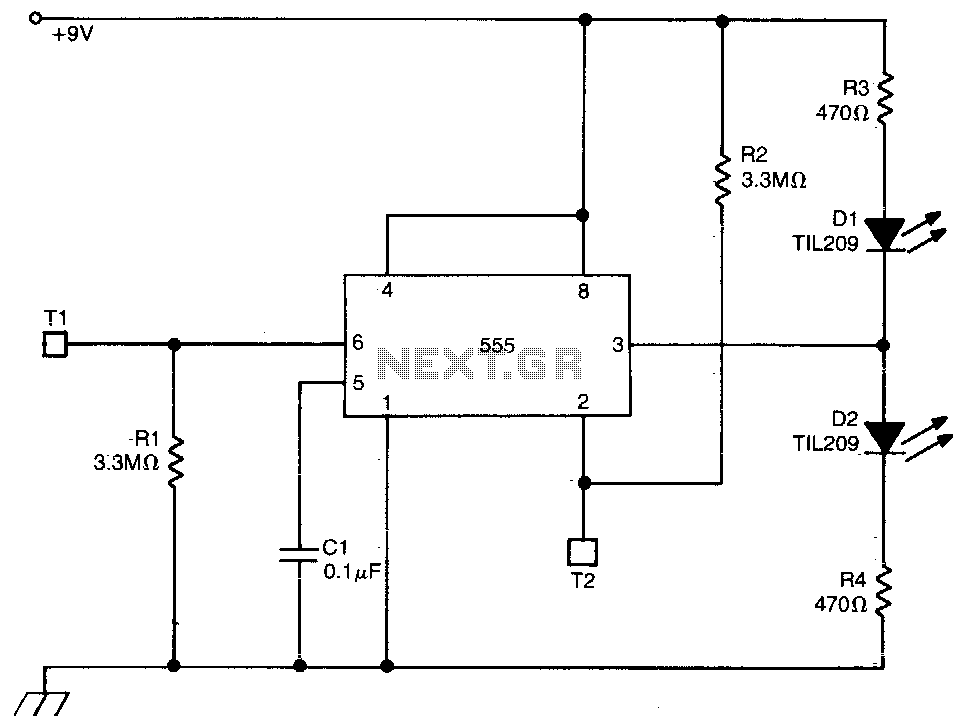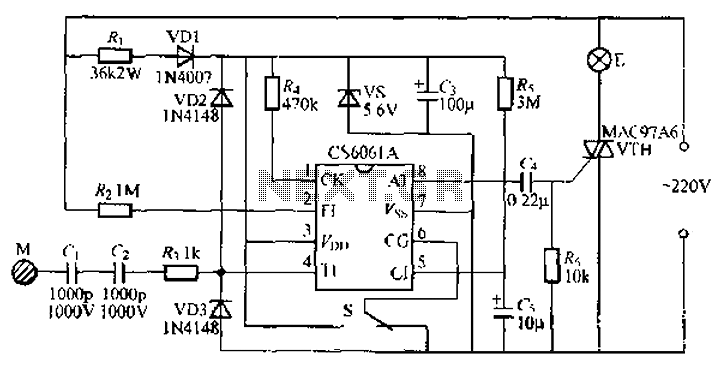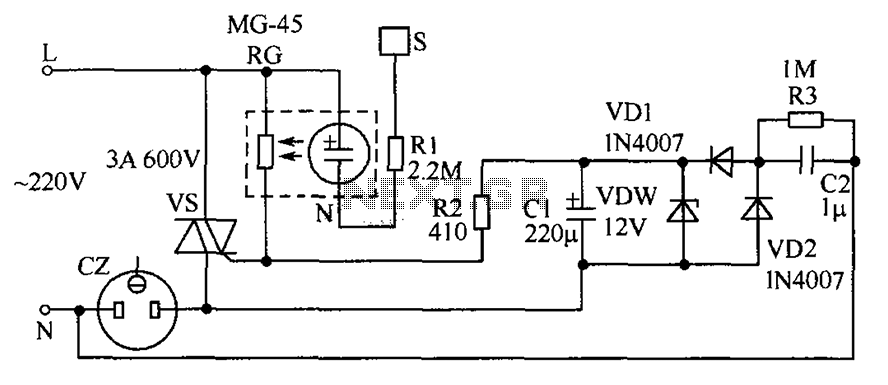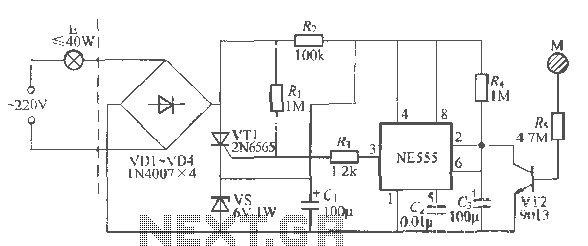
Touch triggered bistable

This circuit employs a 555 timer configured in bistable mode. Activating T2 results in a high output, causing D2 to conduct while D1 turns off. Conversely, activating T1 leads to a low output, with D1 conducting and D2 being cut off. The output from pin 3 is capable of controlling additional circuits, such as a triac-controlled lamp. The inclusion of LEDs is beneficial for locating the touch terminals in low-light conditions. Additionally, capacitor C1 is not strictly required but assists in mitigating unwanted triggering from spurious pulses.
The described circuit utilizes a 555 timer in bistable mode, which is a versatile configuration often used for toggle switches or memory elements. In this mode, the timer can maintain its state until triggered by an external input. The circuit features two touch-sensitive terminals, T1 and T2, which serve as activation points for the timer.
When T2 is touched, it triggers the 555 timer, resulting in a high output signal from pin 3. This signal allows current to flow through diode D2, which illuminates it while simultaneously cutting off current to diode D1, effectively extinguishing it. This visual feedback is critical for users to understand the current state of the circuit.
On the other hand, touching T1 triggers the timer to produce a low output. This action allows current to flow through D1, lighting it up, while D2 is turned off. The ability to toggle between these two states provides a simple yet effective way to control other devices, such as a triac that can manage a lamp or other inductive loads.
The circuit design includes LEDs, which serve a dual purpose: they not only indicate the state of the output but also help users identify the touch terminals in dark environments, enhancing usability.
Capacitor C1, while not essential, can be incorporated to improve the circuit's resilience against false triggering caused by noise or spurious pulses. This is particularly useful in environments with electrical interference, ensuring that the circuit only responds to deliberate touches on the terminals.
Overall, this circuit exemplifies an efficient use of a 555 timer in a bistable configuration, providing a practical solution for touch-sensitive applications with the added benefit of visual indicators.This circuit uses a 555 timer in the bistable mode. Touching T2 causes the output to go high; D2 conducts and D1 extinguishes. Touching T1 causes the output to go low; D1 conducts and D2 is cut off. The output from pin 3 can also be used to operate other circuits ( a triac controlled lamp). In this case, the LEDs are useful for finding the touch terminals in the dark Cl is not absolutely necessary but helps to prevent triggering from spurious pulses.
The described circuit utilizes a 555 timer in bistable mode, which is a versatile configuration often used for toggle switches or memory elements. In this mode, the timer can maintain its state until triggered by an external input. The circuit features two touch-sensitive terminals, T1 and T2, which serve as activation points for the timer.
When T2 is touched, it triggers the 555 timer, resulting in a high output signal from pin 3. This signal allows current to flow through diode D2, which illuminates it while simultaneously cutting off current to diode D1, effectively extinguishing it. This visual feedback is critical for users to understand the current state of the circuit.
On the other hand, touching T1 triggers the timer to produce a low output. This action allows current to flow through D1, lighting it up, while D2 is turned off. The ability to toggle between these two states provides a simple yet effective way to control other devices, such as a triac that can manage a lamp or other inductive loads.
The circuit design includes LEDs, which serve a dual purpose: they not only indicate the state of the output but also help users identify the touch terminals in dark environments, enhancing usability.
Capacitor C1, while not essential, can be incorporated to improve the circuit's resilience against false triggering caused by noise or spurious pulses. This is particularly useful in environments with electrical interference, ensuring that the circuit only responds to deliberate touches on the terminals.
Overall, this circuit exemplifies an efficient use of a 555 timer in a bistable configuration, providing a practical solution for touch-sensitive applications with the added benefit of visual indicators.This circuit uses a 555 timer in the bistable mode. Touching T2 causes the output to go high; D2 conducts and D1 extinguishes. Touching T1 causes the output to go low; D1 conducts and D2 is cut off. The output from pin 3 can also be used to operate other circuits ( a triac controlled lamp). In this case, the LEDs are useful for finding the touch terminals in the dark Cl is not absolutely necessary but helps to prevent triggering from spurious pulses.





